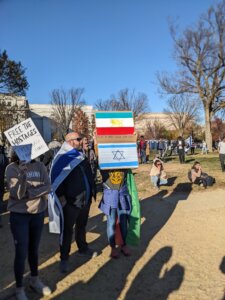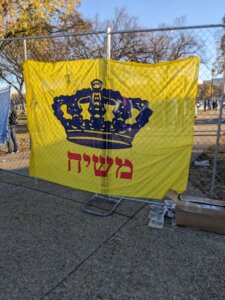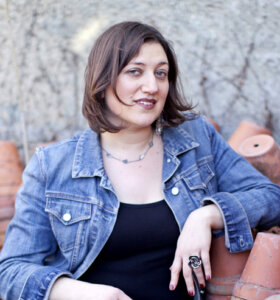I marched for Israel with 300,000 people — so why is the media so obsessed with the fringe?
The Jewish people can’t let their narrative be kidnapped

Participants hold up posters of hostages at the March for Israel Nov. 14. Photo by Getty Images
The massive March for Israel in Washington, D.C., was the largest rally of the Jewish community in my lifetime, and attending it convinced me that there are three important marches going on right now.
The first march is about physical presence — providing evidence to the political world as well as the world at large that Israel and the Jewish community have strength and support.
The second is for accurate news coverage; how this event was described in many news outlets provided a case study in misleading framing.
And the third is to strengthen Jews, and to convince the world Jewish community, from within, of the necessity of standing together in this terrifying moment, when prior demonstrations in support of Israel have turned violent and even deadly.
Here’s what I saw with my own eyes: people of all ages. A big delegation from Milwaukee, decked out in Israeli-flag stickers on the backs of jackets; another from Minnesota, wearing matching maroon T-shirts featuring a map of their state. College students from the University of North Florida; eighth graders from Manhattan Day School; a man who had to be in his 90s, walking with a walker with his community; seminary girls in long black skirts; Chabad; groups davening mincha; a middle-aged man who prayed for the entirety of the entire rally; several people flying the flag of Iran.
To me, this march and its aftermath were all about what was missing.
The undercount
Let’s start with numbers. An incredible 290,000 people marched, according to the Jewish Federations of North America, The Conference of Presidents of Major Jewish Organizations, and Haaretz.
But many news accounts published after the march said “thousands” or “tens of thousands” had attended — a far cry from hundreds of thousands. This was a significant diminishing of the turnout.
What do 290,000 in-person marchers mean in terms of the world Jewish community? That’s 1 in 50 living Jews. And the more than 400,000 viewers who watched online mean it was even bigger. The New York Times published a photo of the march on its front page, but the article didn’t appear until page A21.

My father, who was with me, compared the March for Israel to the 1963 March on Washington.
“One thing was that in this particular place, we couldn’t move; in the 1963 March on Washington, you could move around more,” my father said. “Martin Luther King was on the steps of the Washington Monument, and I could see him. I was that close. This time, the speakers seemed to be in an area for those with blue wristbands. We only had a television screen with no captions. It was disappointing.”
Maybe that’s because, according to a CBS News report published before the event, the organizers expected 60,000 people. And 290,000 showed up.
Numerous New York Times readers took to the comments section to object to the undercount, and the shaping of the event.
“This was a beautiful march for Israel’s right to exist, against antisemitism, and to free the hostages. Many of the speakers spoke about the plight and asked us to pray for Jews and Palestinians alike. Tens of thousands is misleading, there are estimates of 290,000 and the entire Mall was filled. There were people of many faiths and ethnicities represented,” one Times reader commented.
Yet that was not the sense a reader would get from many news reports.
Misleading news coverage
On the outskirts of the march, there was a group of Neturei Karta — Haredi Jews who want the dismantlement of the state of Israel, and whose leaders have met with Iranian President Mahmoud Ahmadinejad in New York and Tehran, and have also met with Hamas leaders in Gaza and Hezbollah brass in Lebanon.
They carried signs with slogans like “Zionism is Not Judaism.”

“What is that?” a 60-something Jewish woman from Milwaukee’s delegation asked as she walked by.
Though the Neturei Karta are a fringe movement, they were the headline and photo in the coverage of TRT World, the news outlet of Turkish Radio and Television Corporation, the national public broadcaster of Turkey.
“Rival groups trade barbs at pro-Israel rally in Washington,” the headline read.
Reuters, which went with “tens of thousands” as its estimate of attendance, and “busloads” of senators, also covered the Neturei Karta, but did not capture just how fringe the Neturei Karta is.
“The problem is,” a Hasidic woman on the bus from Monsey to Manhattan the day after the march told me, “they look like us, but no one agrees with them.”
Giving air time to one voice
On the way out of the march, my mother and I passed a lone woman holding a “Cease Fire Now” sign. The woman was surrounded by reporters holding microphones.
When we got home, we were eager to hear how the PBS NewsHour covered the march. After a very brief report, the news show instead featured six American Jews discussing their views on the Hamas-Israel war. One of them was Medea Benjamin, co-founder of Code Pink, who had been holding that sign.
Code Pink, according to its website, “recognizes Palestinians as the rightful owners and caretakers of Palestine, their indigenous homeland.”
“We support Palestinians’ right to resist the violent Israeli occupation of Palestine. We are committed to supporting Palestinian liberation from abroad, using the demands of Palestinians as our guideline for organizing, and we endorse the BDS movement,” the website goes on to say.
Though these are not views that represent the great majority of the Jewish community, there is no way an uninformed PBS NewsHour viewer would know that.
As days passed, I saw more and more egregious news coverage, not just ignoring the vast majority of marchers, but actively maligning them. World Socialist News claimed that the marchers had been sent by the State Department.
Misplaced emphasis is a major problem
What is particularly appalling is how much coverage of the march has been devoted to fringe views.
Here were nearly 300,000 Jews, standing together in support of Israel’s existence, demanding the safe return of hostages, and protesting antisemitism. None of these three goals are represented by Code Pink or the Neturei Karta.
What also struck me is the Jewish illiteracy displayed by the press. This rally featured multiple prayers — extremely moving when said by hundreds of thousands of people. This was a sober crowd with serious concerns and existential worries.
There was Psalm 121, “I cast my eyes unto the mountains,” said in times of trouble. There was the prayer for the safety of Israeli soldiers. There was the prayer for the state of Israel. And at the end, there was the beautiful acheinu kol beit Yisrael, sung for those in captivity, a mixture of Hebrew and Aramaic, a hint of the long history of the Jewish people. None of the news accounts I saw mentioned any of it.
The Jewish people need to communicate with ourselves, and not let the narrative be kidnapped. What I saw in person was presence, and a lot of it. What I saw in news coverage was erasure — of Jewish people, of Jewish points of view, of Jewish prayers, and Jewish language.






















